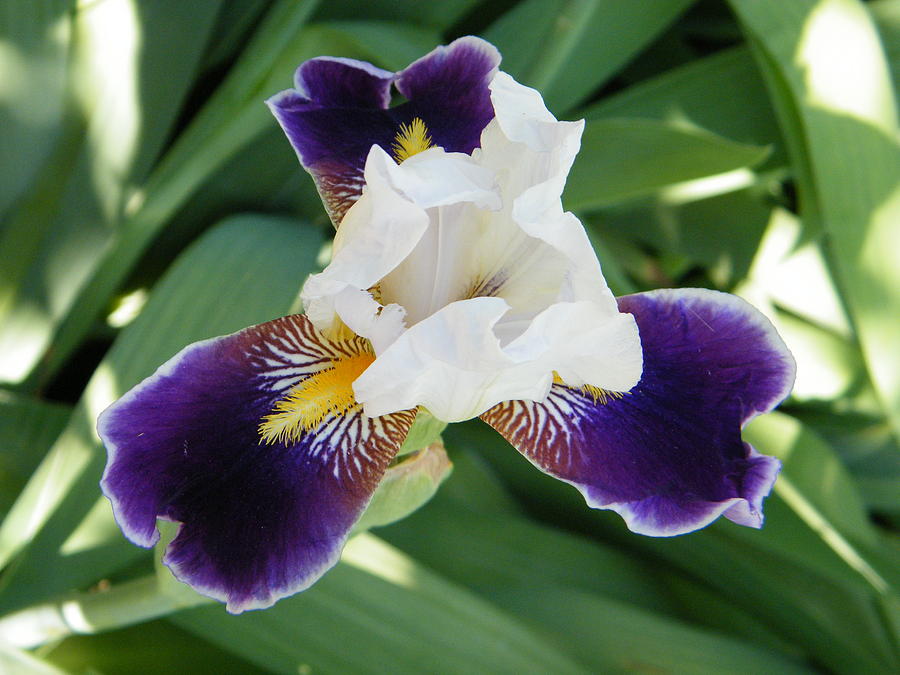Iris come in a rainbow of colors, but the elegant pairing of white and purple blooms creates an especially beautiful effect. These classic iris tones complement each other perfectly. Adding both white and purple iris to your garden guarantees a showstopping display.
The Allure of Purple Irises
Purple is one of the most popular and recognizable iris shades. Ranging from pale lavender to deep violet, purple iris showcase the graceful blooms and add rich color. Purple varieties include:
-
Butter and Sugar – pale purple standards with white falls
-
Montmartre – velvety purple-violet
-
Paul Black – dark violet
-
Caesar’s Brother – royal purple
-
Batik – reddish purple plicata
-
Eye of the Tiger – purple standards, yellow falls
Purple iris look regal combined with pastel blossoms or cool whites. They pop against spring greenery. Plant en masse for bold swathes of purple.
Elegant White Iris Varieties
White iris lend an air of sophistication to the landscape. Crisp and pristine, they shine in the garden. Choose from pure whites to those kissed with pale color:
-
Immortality – pure white
-
Queen’s Circle – white with yellow beards
-
White City – glistening white
-
Angel’s Blush – white with pale pink blush
-
Tropical Tigress – white standards, yellow falls
-
Going My Way – white with purple edges
White iris pairs perfectly with any hue and helps brighten shady spots. Use them as accents throughout planting beds.
Combine White and Purple for Drama
When planted together, white and purple iris play off each other for a dramatic effect. Purple stands out against the white blooms, creating a beautiful contrast. White helps brighten the purple tones. Here are some tips for combining these classic colors:
-
Plant in drifts – mass purple iris in sweeps among swathes of white
-
Use purple as accents – dot dark purple iris among mostly white varieties
-
Edge with white – border purple groupings with a rim of white blooms
-
Highlight focal points – feature purple iris prominently against white
-
Contrast foliage – pair purple flowers with white variegated hosta or grass
-
Add vertical elements – intersperse tall purple spires through low mounds of white
Extend the Bloom Season
Stagger the bloom times of the purple and white iris to enjoy weeks of color. Early, mid, and late season varieties ensure continuous flowering. For example:
-
Early – Caesar’s Brother (purple), Immortality (white)
-
Mid – Montmartre (purple), Angel’s Blush (white)
-
Late – Paul Black (purple), White City (white)
Alternate planting groups of early and late bloomers to provide a steady display. Deadhead spent blooms to encourage reblooming.
With complementary hues and shapes, white and purple iris are natural companions. Their timeless elegance and visual appeal lend character to any garden. Show off these iris beauties together for a designer look.
How to Care for Irises
Are irises ornamental?
While not all types of iris are suited for use in the ornamental landscape, many specialized heirlooms and hybrids are ideal additions to cut flower gardens and in decorative flower beds. Though most irises are known for their distinctive true blue color, white iris varieties have gained popularity.
Are Iris a perennial?
The iris is a perennial flowering plant that belongs to the Iridaceae family. It is known for its beautiful showy flowers. They come in a variety of colors, including shades of blue, purple, pink, yellow, white, and brown, and may have patterns or markings on them.
What are the different types of white irises?
Gull’s Wing is also one of the more showy white iris varieties, as each petal is large and wide. Additionally, white Siberian irises seldom have issues with disease or damage caused by insects. “Immortality” Bearded – White bearded irises are quite common in ornamental gardens. The cultivar Immortality produces large, pure white flowers.
How tall do purple irises get?
Generally sorted into bearded and beardless categories, irises can range in height from 6 inches to 4 feet and have great variations in sun preferences, scent profiles, and maintenance needs. To help you in your quest to add some purple iris joy to your garden, we’ve gathered facts, photos, and growing profiles on 15 of our favorites.
- The Ultimate Guide to Growing Strawberries in Raised Beds - August 8, 2025
- No-Dig Garden Beds: The Easiest Way to Grow a Beautiful Garden - August 6, 2025
- How to Protect and Preserve Wood for Raised Garden Beds - August 6, 2025

